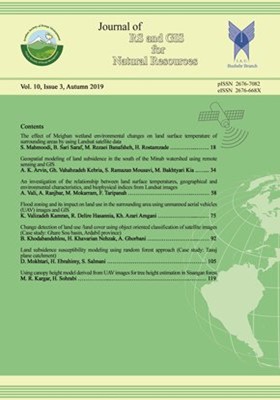-
-
List of Articles
-
Open Access Article
1 - The effect of Meighan wetland environmental changes on land surface temperature of surrounding areas by using Landsat satellite data
Saeed Mahmoodi Behrouz Sari Saraf Majed Rezaei Banafsheh Hashem Rostamzade -
Open Access Article
2 - Geospatial modeling of land subsidence in the south of the Minab watershed using remote sensing and GIS
Abdolkhalegh Arvin Ghorban Vahabzadeh Seyed Ramazan Mousavi Masoud Bakhtyari Kia -
Open Access Article
3 - An investigation of the relationship between land surface temperatures, geographical and environmental characteristics, and biophysical indices from Landsat images
Abbasali Vali Abolfazl Ranjbar Marzieh Mokarram Farideh Taripanah -
Open Access Article
4 - Flood zoning and its impact on land use in the surrounding area using unmanned aerial vehicles (UAV) images and GIS
Khalil Valizadeh Kamran Reza Delire Hasannia Khadije Azari Amghani -
Open Access Article
5 - Change detection of land use /land cover using object oriented classification of satellite images (Case study: Ghare Sou basin, Ardabil province)
Behrooz Khodabandehlou Hassan Khavarian Nehzak Ardavan Ghorbani -
Open Access Article
6 - Land subsidence susceptibility modeling using random forest approach (Case study: Tasuj plane catchment)
Davoud Mokhtari Hamid Ebrahimy Saeed Salmani -
Open Access Article
7 - Using canopy height model derived from UAV images to tree height estimation in Sisangan forest
Mohammad Reza Kargar Hormoz Sohrabi
-
The rights to this website are owned by the Raimag Press Management System.
Copyright © 2021-2025







